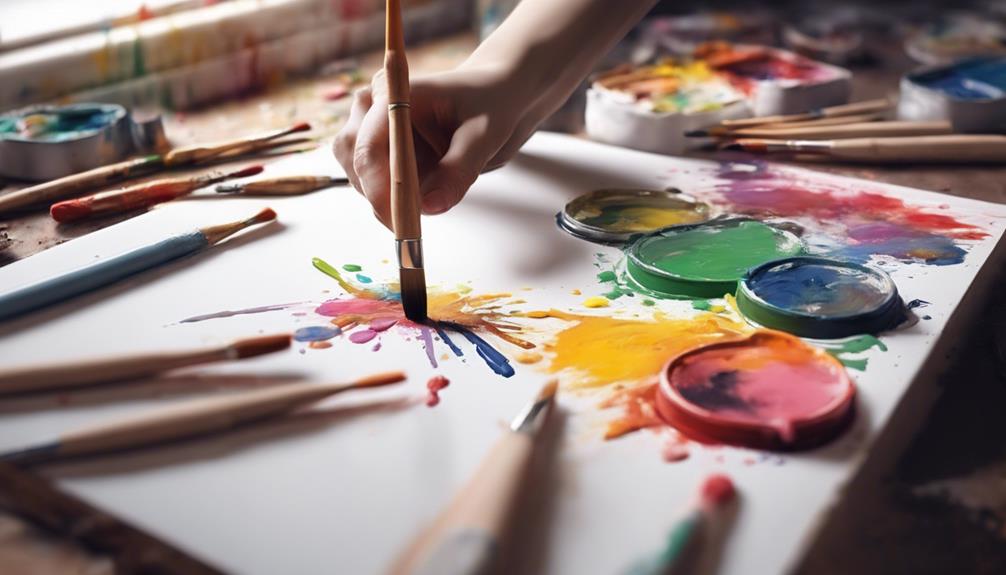Embarking on the journey of drawing or painting necessitates a systematic approach that incorporates foundational principles and techniques. To commence this artistic pursuit, one must familiarize themselves with the rudiments of art, ranging from basic lines and shading to more complex aspects like proportions and perspective. However, the question remains – how does one translate these theoretical concepts into practical application effectively? By delving into the intricacies of warm-up exercises, mastering hand-eye coordination, and selecting the right tools, one can begin to unravel the mysteries of artistic creation. But what lies beyond these initial steps, and how does one further refine their craft to achieve artistic mastery?
Key Takeaways
- Begin with warm-up exercises to prepare, prevent injuries, and enhance focus.
- Understand basic shapes to break down complex objects and sharpen observational skills.
- Master hand-eye coordination through various exercises and seek feedback for improvement.
- Utilize light lines, shading techniques, and loose sketching for artistic development and progression.
Importance of Warm-Up Exercises
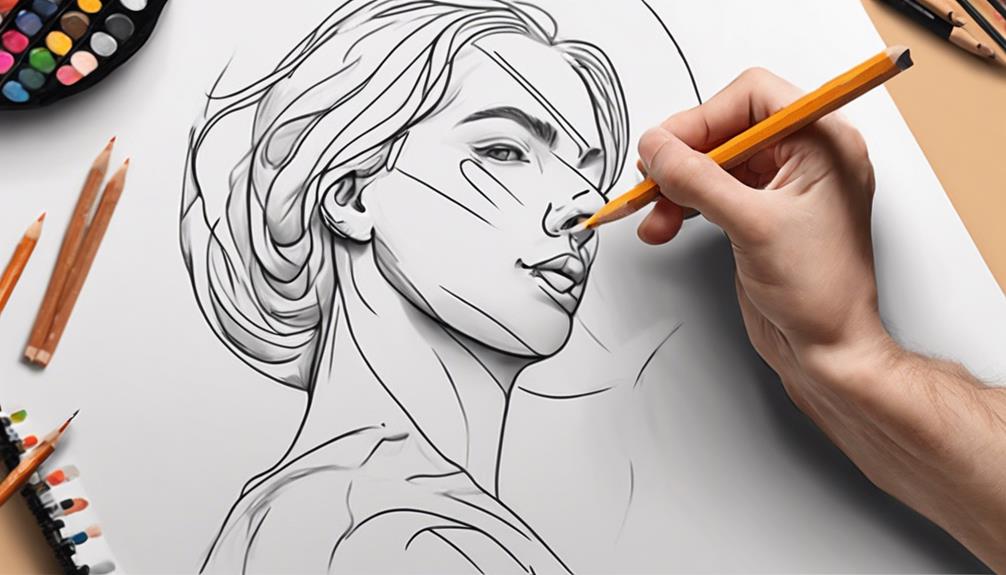
Warm-up exercises play a crucial role in preparing the drawing muscles and enhancing essential motor skills required for precise artwork execution. These exercises are vital for artists as they help improve hand-eye coordination and fine motor skills, which are essential for creating detailed and accurate drawings. By engaging in warm-up activities such as simple mark-making, doodling, or sketching basic shapes, artists can loosen up their muscles and get into a creative flow before tackling more complex projects.
Furthermore, warm-up exercises are not only beneficial for enhancing artistic skills but also for preventing injuries and strain during long drawing or painting sessions. By incorporating warm-up routines into their art practice, artists can boost their focus, concentration, and overall performance. Therefore, dedicating time to warm-up exercises before starting a drawing or painting session can significantly improve the quality of the artwork produced while also promoting physical well-being.
Understanding Basic Shapes
Understanding basic shapes is fundamental in art as they serve as the foundational elements for more complex forms in drawing and painting. Basic shapes such as circles, squares, triangles, and rectangles act as the building blocks upon which intricate artwork is constructed. By grasping these simple shapes, artists can break down complex objects into manageable components, aiding in accurate representation and proportion in their work.
Practice is essential in mastering the art of drawing basic shapes. Regularly sketching these fundamental forms from various perspectives sharpens spatial awareness and hones observational skills. Through consistent practice, artists develop the ability to visualize and recreate shapes with precision and accuracy.
Mastery of basic shapes lays the groundwork for creating realistic and detailed artwork. Artists who understand the principles of basic shapes can more effectively capture the essence of objects, people, and scenes in their drawings and paintings. By honing their skills in working with basic shapes, artists can elevate the quality and realism of their artistic creations.
Mastering Hand-Eye Coordination
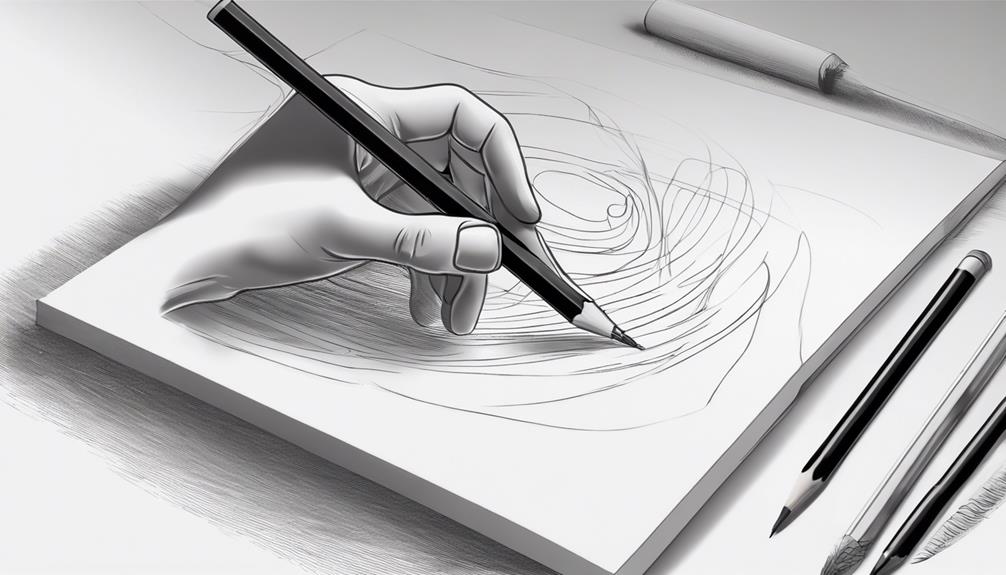
Enhancing hand-eye coordination is a crucial skill for artists seeking to improve precision and accuracy in their drawing and painting endeavors. To master hand-eye coordination, artists should engage in various exercises such as drawing basic shapes and lines to enhance precision. Activities like tracing, copying images, and drawing from observation can also help improve coordination skills. Utilizing a variety of drawing tools like pencils, pens, and markers is essential to develop the coordination between hand movements and visual perception. Experimenting with different drawing surfaces and textures can challenge and refine hand-eye coordination abilities further. Seeking feedback and guidance from experienced artists or art teachers is valuable for identifying areas of improvement in hand-eye coordination. Below is a table highlighting key aspects related to mastering hand-eye coordination:
| Hand-Eye Coordination | Drawing Tools |
|---|---|
| Practice basic shapes | Pencils |
| Engage in tracing | Pens |
| Experiment with textures | Markers |
Incorporating Light Lines
Incorporating light lines is a fundamental technique in drawing that aids in outlining the initial shapes of a subject. These initial lines serve as a guide for adding defining details and enhancing the drawing with shading. By starting with light, delicate strokes, artists can gradually refine their compositions with precision and control.
Sketching Initial Shapes
When starting a drawing or painting, initiating the process by lightly sketching basic shapes such as circles, squares, and triangles forms the foundation for outlining the primary elements of your artwork. This method allows you to establish the overall composition and proportions before delving into adding intricate details. Here are some emotional cues to guide you through this process:
- Embrace the freedom of creativity that comes with sketching initial shapes.
- Feel the excitement of gradually refining the shapes to bring your vision to life.
- Experience the satisfaction of practicing with light lines to enhance your skills.
- Enjoy the process of adjusting and modifying the initial sketches to achieve precision.
- Build confidence in your artistic abilities through consistent practice and dedication.
Adding Defining Details
After establishing the foundational shapes in your drawing or painting, the next step involves delicately incorporating light lines to add defining details and enhance the overall depth and dimension of your artwork. Light lines play a crucial role in outlining specific features, refining edges, and adding intricacies to the composition. By varying line weights and applying these lines thoughtfully, artists can create a sense of depth and dimension within their work. These lines help in providing a polished look to the artwork, adding texture where needed, and guiding the viewer's eye across the piece. Utilizing light lines effectively can elevate the overall quality of the artwork and contribute to a more visually engaging and detailed final product.
Enhancing With Shading
Enhancing a drawing or painting through shading involves skillfully incorporating light lines to create depth and dimension within the artwork. Light lines play a crucial role in shading by gradually building up layers for a realistic effect. They help define the direction of the light source and guide the artist in planning the shading accordingly. By practicing varying pressure and stroke lengths with light lines, artists can achieve a more nuanced shading technique. Additionally, light lines can be utilized to map out highlights and areas of contrast, adding further depth and dimension to the artwork. Mastering the use of light lines in shading is essential for creating visually captivating and dynamic pieces.
Adding Volume and Solid Lines
To enhance the three-dimensional quality of your drawings, mastering the technique of adding volume and solid lines is essential. Volume in drawing refers to the illusion of depth and solidity within an object. Shading techniques such as hatching and cross-hatching can be used to add volume by creating variations in light and shadow. Experimenting with different line weights is another effective way to emphasize the structure and solidity of objects. By varying the thickness and darkness of your lines, you can create a sense of weight and depth in your drawings. It is beneficial to practice drawing basic geometric shapes to understand how to render solid forms with volume accurately. Additionally, studying how light interacts with objects can help you create more realistic and dimensional drawings. Understanding these concepts and techniques will greatly enhance the visual appeal and realism of your artwork.
The Art of Loose Sketching
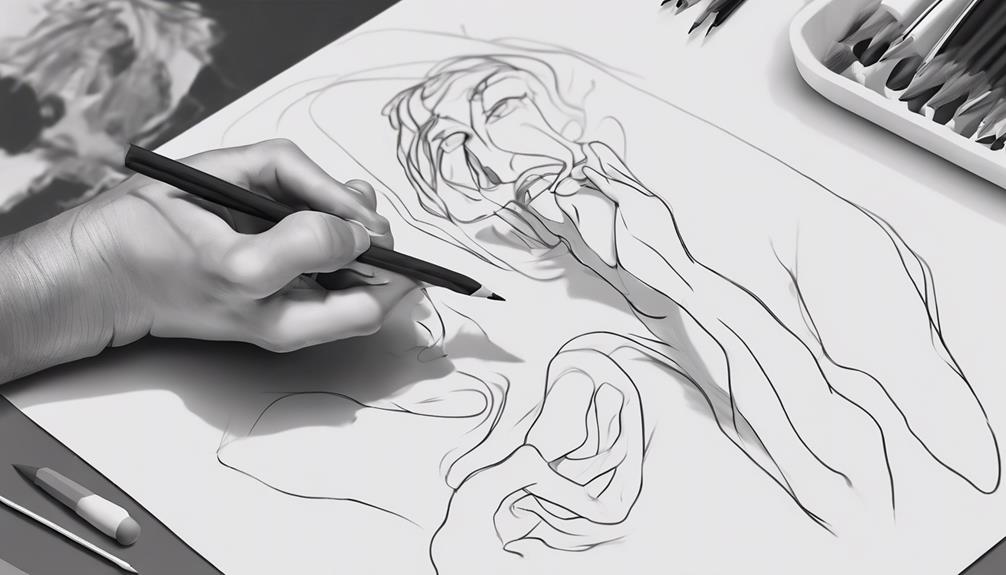
Understanding the foundational principles of loose sketching is paramount for artists seeking to capture the essence and energy of their subjects with fluidity and spontaneity. When practicing the art of loose sketching, artists should keep in mind the following key points:
- Begin with light, loose lines to outline the basic shapes of your subject.
- Use quick, gestural strokes to capture the overall movement and energy of the subject.
- Focus on capturing the essence and mood rather than intricate details in the initial sketch.
- Experiment with different mark-making techniques to add depth and character to your sketches.
- Practice regularly to develop confidence and fluidity in your loose sketching style.
Focusing on Contrast and Details
Utilizing contrast effectively in artwork plays a crucial role in enhancing visual impact and detailing. When working on drawing paper, the interplay between light and shadow can significantly influence the contrast in your artwork. By carefully observing how light interacts with your subject, you can create a dynamic range of values from light to dark, adding depth and dimension to your piece. Experimenting with different levels of contrast allows you to bring out fine details and textures, making your art more engaging and realistic. Paying attention to the subtle variations in contrast can help emphasize specific areas of interest and guide the viewer's eye across the composition. Practice incorporating fine details, such as intricate patterns or textures, to further enhance the overall contrast and visual interest in your work. By mastering the use of contrast and detailing, you can elevate the quality of your drawings or paintings, making them more compelling and visually appealing.
Learning From Mistakes
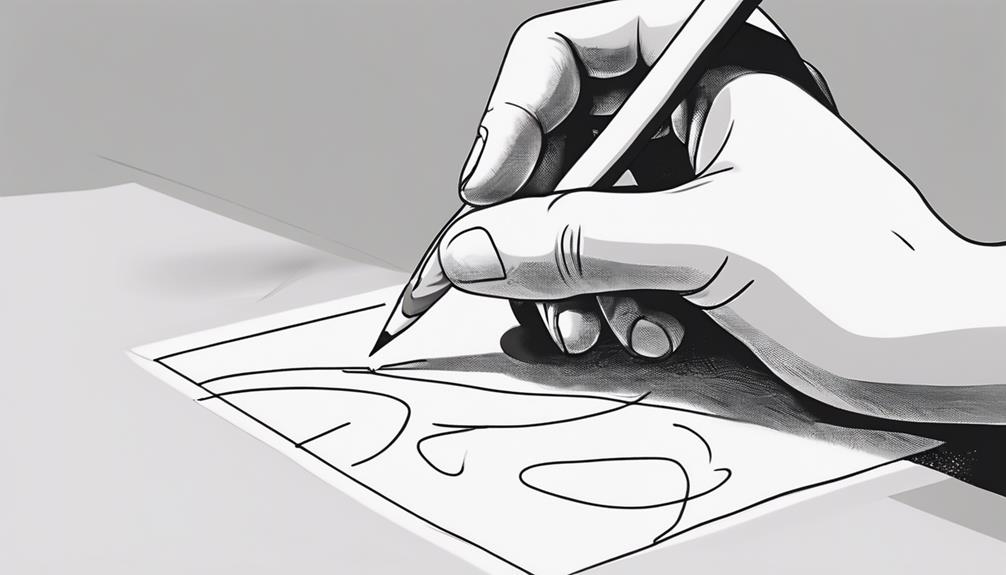
Embracing mistakes in the realm of drawing and painting serves as a vital pathway to growth and refinement in artistic skills. Mistakes, often seen as setbacks, can be transformed into stepping stones towards improvement through a structured approach. Here's how:
- Opportunities for Growth: Mistakes provide a chance to learn and enhance your skills.
- Analyzing Errors: Understanding why mistakes occur helps in identifying areas for improvement.
- Refining Techniques: Using mistakes as a guide, refine your techniques to avoid repeating errors.
- Experimentation: Trying different approaches helps in overcoming mistakes and fostering creativity.
- Path to Mastery: Viewing mistakes positively enables you to progress towards mastery and artistic development.
Exploring Advanced Concepts
Advanced artistic development involves delving into intricate concepts such as 3D volumes, perspective, values, light, and shadow to elevate the depth and sophistication of your creations. Understanding 3D volumes allows artists to represent objects with depth and realism on a two-dimensional surface. Perspective, through techniques like foreshortening, is crucial for creating the illusion of space and distance in artworks. Values, the range of lightness and darkness in an artwork, help to define form and create contrast. Light plays a pivotal role in how objects are perceived, affecting their volume, texture, and overall appearance. Experimenting with different lighting scenarios can enhance the understanding of how light interacts with objects.
To advance your artistic skills further, studying advanced composition techniques can help in creating visually engaging and dynamic artworks. Additionally, exploring color theory and its impact on mood, atmosphere, and storytelling in paintings can elevate the emotional depth of your creations. By mastering these advanced concepts, artists can create more compelling and sophisticated pieces of art.
Essential Drawing Tools
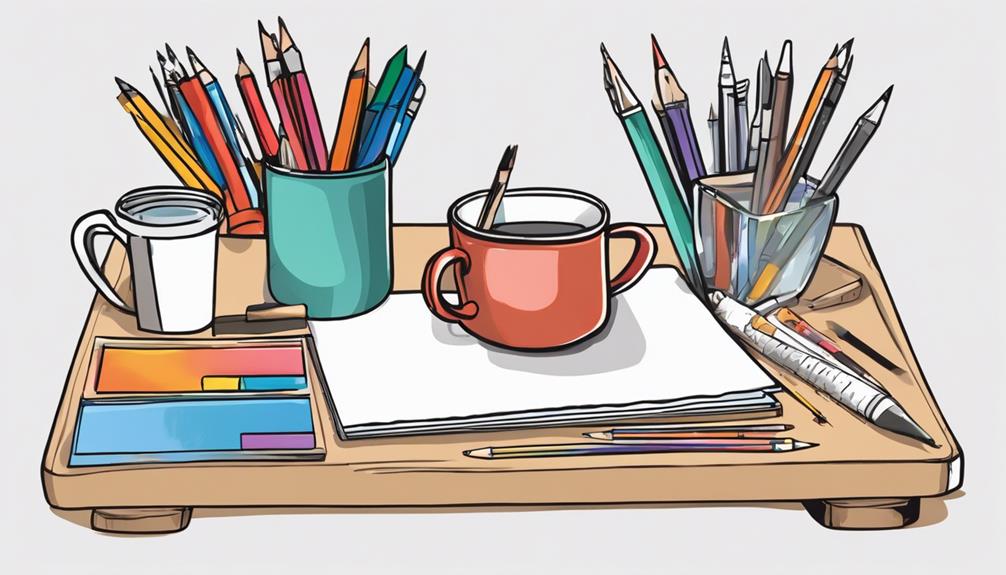
When embarking on the journey of drawing or painting, understanding the fundamentals of essential drawing tools is essential. Pencils of varying hardness, ink liners, brushes, erasers, and blending tools are crucial for creating diverse line types and shading effects. Mastery of these tools allows artists to develop their skills and produce intricate, realistic artwork.
Basic Drawing Supplies
What are the essential drawing tools that one must have to begin the journey of drawing or painting effectively? Basic drawing supplies play a crucial role in laying the foundation for artistic creation. These tools include a variety of pencils such as HB, 2B, and 4B for different shading effects, erasers like kneaded and vinyl for precision, quality paper like sketchbook or drawing paper to bring sketches to life, sharpeners to maintain pencil tips, and rulers for accurate measurements and straight lines. Each of these items serves a specific purpose in aiding artists to express their creativity with finesse and accuracy. Together, they form the backbone of any artist's toolkit, enabling them to bring their imagination to life on paper.
Must-Have Painting Tools
To excel in the realm of painting, acquiring essential drawing tools such as pencils of varying hardness, erasers, blending tools, ink liners/brushes, and white ink for highlights is paramount. Pencils offer the versatility needed to achieve different darkness levels and textures in drawings. Erasers play a crucial role in correcting mistakes and refining details. Blending tools, including techniques like hatching and stippling, are essential for shading and creating depth in artwork. Ink liners and brushes provide precision and allow for intricate detailing in drawings. Understanding the capabilities of these tools is fundamental for mastering shading techniques and developing a unique artistic style. Experimenting with a variety of drawing tools enables artists to explore different approaches to drawing and painting.
Essential Sketching Materials
Quality sketching begins with essential drawing tools, including pencils of different hardness, erasers, blending tools, and specific types of paper. When it comes to sketching materials, several key items play a crucial role:
- Varying Pencil Strokes: Experimenting with different pencil strokes can add depth and texture to your sketches.
- Quality Paper: Choosing the right paper with suitable texture and weight is vital for mastering various drawing techniques.
- Diverse Drawing Tools: Utilizing a range of drawing tools such as graphite, charcoal, or colored pencils enhances versatility in sketching.
- Rulers and Sharpeners: These tools aid in precision and maintaining sharp pencil points for detailed work.
- Exploration and Experimentation: Trying out different drawing tools not only helps in understanding their effects but also aids in skill improvement.
Navigating Different Drawing Mediums
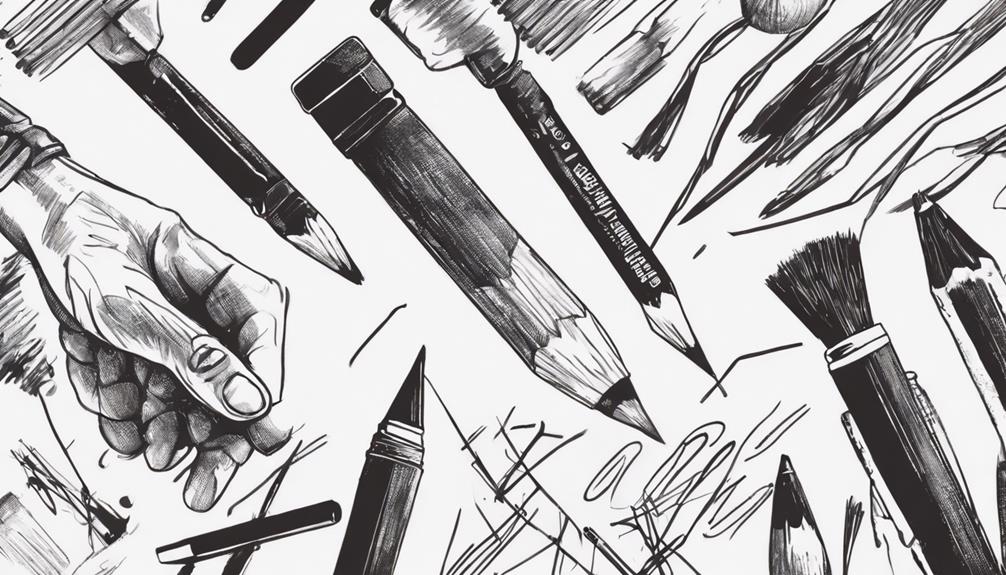
Exploring the diverse world of drawing mediums is essential for artists seeking to expand their creative repertoire and achieve desired artistic effects. Acrylic paint, known for its quick drying time and budget-friendly nature, is an excellent choice for beginners looking to experiment with vibrant colors. On the other hand, oil paints offer a high level of versatility and are favored by professionals for their ability to blend smoothly and create rich textures, making them ideal for traditional painting techniques. Watercolors, although challenging due to their transparent nature, can produce elegant and subtle effects that complement other mediums beautifully. Understanding the characteristics, advantages, and disadvantages of each medium is crucial for artists to choose the one that best suits their artistic vision. Additionally, selecting the appropriate painting mediums and supplies, such as brushes and paints, is essential for achieving optimal results in artistic endeavors. By navigating the different drawing mediums available, artists can enhance their skills and create captivating works of art.
Painting Supplies Essentials
Upon embarking on your artistic journey and familiarizing yourself with different drawing mediums, it is imperative to understand the essential painting supplies that are fundamental for your creative endeavors. To ensure a successful start, consider the following key painting supplies:
- Brushes: Invest in a variety of brushes suitable for different techniques and effects.
- Canvas/Paper: Choose high-quality surfaces like canvas or paper to enhance the longevity and appearance of your artwork.
- Quality Supplies: Opt for premium paints, palettes, and mediums to achieve better results and improve your painting experience.
- Palette Knives: Useful for mixing colors and creating textured effects, palette knives are versatile tools in painting.
- Easel: A sturdy easel provides a comfortable working position and helps you display your artwork effectively.
Starting with these essential painting supplies and focusing on quality over quantity will set a strong foundation for your artistic pursuits. Experimenting with different mediums and surfaces will further enrich your understanding of painting techniques.
Pursuing Drawing and Painting as Hobbies
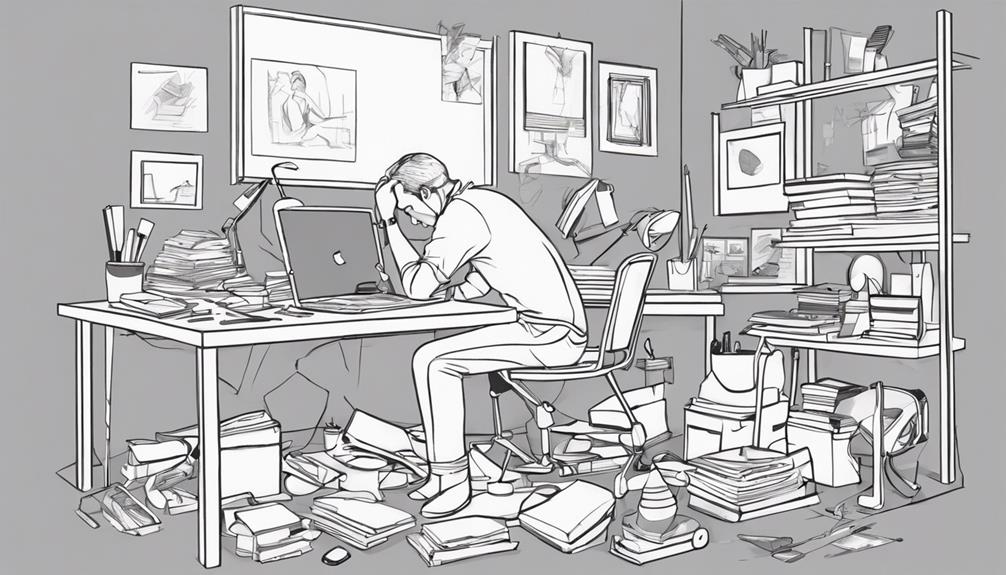
Engaging in drawing and painting as recreational pursuits can offer a fulfilling creative outlet and a platform for personal expression. To embark on this journey, beginners should start by sketching basic shapes and practicing different drawing techniques to establish a strong foundation in drawing skills. Experimenting with various art supplies and tools is crucial to understand their capabilities and determine which ones work best for individual preferences. Additionally, exploring online tutorials, classes, and resources can provide valuable insights into learning new skills and painting techniques.
Joining art communities or groups is beneficial as it allows artists to connect with peers, share their work, and receive constructive feedback for improvement. Setting aside dedicated time for regular practice and experimentation is essential to enhance drawing and painting skills as a hobby. By following these steps and continuously refining one's techniques, individuals can grow and develop their artistic abilities in drawing and painting.
Frequently Asked Questions
How Should Beginners Start Drawing?
For beginners in drawing, starting with basic techniques such as understanding shapes, lines, and shading is crucial. Engaging in sketching exercises to practice these fundamentals can greatly enhance skills. Acquiring essential drawing supplies and exploring online tutorials for guidance can also be beneficial. By gradually building proficiency through structured learning and consistent practice, beginners can develop a solid foundation in drawing, setting the stage for further artistic growth.
How Do I Start Drawing With No Experience?
To embark on a drawing journey devoid of experience, embrace basic techniques like line work and shading to establish a foundation. Experiment with various drawing tools such as pencils and erasers to understand their nuances. Beware of common beginner mistakes like rushing through details or lacking patience. Seek inspiration from nature, art, or personal experiences to ignite creativity. By immersing oneself in practice and exploration, the path to artistic proficiency begins to unfold.
What Is the First Step to Learn Drawing?
To initiate the learning process in drawing, one should focus on mastering basic techniques, engage in sketching exercises to enhance hand-eye coordination, experiment with various drawing supplies to understand their uses, and seek artistic inspiration from diverse sources. By starting with fundamental skills and gradually progressing to more complex concepts, individuals can develop a strong foundation in drawing, enabling them to express their creativity and artistic vision effectively.
What Is the First Thing You Should Learn to Draw?
Mastering basic shapes lays the foundation for drawing proficiency. Understanding lines, proportions, and shading techniques is crucial. These fundamental skills form the backbone of artistic expression. By starting with basic shapes, aspiring artists develop a solid understanding of form and structure. Line work helps in creating accurate outlines, while proportions ensure realistic representations. Shading techniques add depth and dimension, enhancing the visual impact of drawings. This structured approach equips artists with essential skills for artistic endeavors.
Conclusion
In conclusion, the journey of drawing and painting begins with mastering the fundamentals of art through practice and dedication. By engaging in warm-up exercises, understanding basic shapes, and honing hand-eye coordination, artists can enhance their skills. Incorporating light and solid lines, utilizing essential drawing tools, and exploring different mediums are essential steps in developing artistic proficiency. Embrace the creative process as a means to unlock the endless possibilities of expression and imagination.
